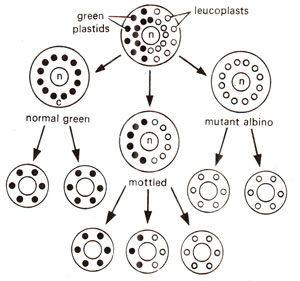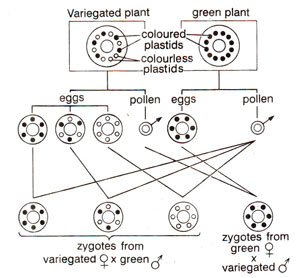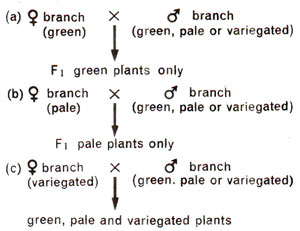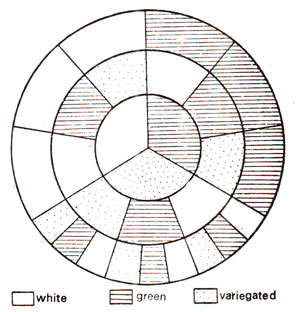Plastid inheritance : variegation in plants

Fig. 18.7. Distribution of green piastids and leucoplasts during gamete formation.

Fig. 18.8. Distribution of coloured and colourless plastids in eggs produced in variegated plant used as ♀ and their effect on progeny obtained due to a cross with normal green plant used as male (♂) parent. The results of a reciprocal cross (green ♀ x variegated ♂) are also shown.

Fig. 18.9. Plastid inheritance in four o'clock showing dependence on the nature of female branch.

Fig. 18.10. Plastid inheritance in four o'clock. The central circle represents the type of branch that produces flower which are pollinated. Intermediate circle represents branch from which pollen is used and outer circle shows progeny.

Fig. 18.11. Inheritance of iojap striping in maize showing dependence on the phenotype of female parent.
It is believed that variation in colour of leaves, branches or whole plants is due to two kinds of plastids (normal and mutant albino). These two types of plastids will faithfully multiply and give rise to their own types due to cell division. But these daughter plastids may not equally distribute themselves to daughter cells. Further, in rapidly dividing cells, division of plastids may not keep pace with cell division, so that distribution of plastids to daughter cells may become a chance phenomenon as illustrated in Figure 18.7. A cell having both kinds of plastids may give rise to three types of cells namely (i) those with mainly normal green plastids; (ii) those with mainly mutant albino plastids and (iii) those with both kinds of plastids. These three kinds of cells when present as eggs will give three kinds of progenies. However, these three kinds of cells will not be distinguished as sperms and, therefore, variegated plant when used only as male will give only one kind of progeny (Fig. 18.8).

Fig. 18.7. Distribution of green piastids and leucoplasts during gamete formation.

Fig. 18.8. Distribution of coloured and colourless plastids in eggs produced in variegated plant used as ♀ and their effect on progeny obtained due to a cross with normal green plant used as male (♂) parent. The results of a reciprocal cross (green ♀ x variegated ♂) are also shown.
Plastid, inheritance in four o'clock (Mirabilis jalapa).
Although a number of cases are now known in plants, where inheritance of plastids is controlled by genes, there are also cases where this character is transmitted through the agency of cytoplasm alone. Since major part of cytoplasm in zygote is derived from egg, inheritance in such cases will be maternal.
In four o'clock plant (Mirabilis jalapa), three kinds of branches with respect to occurrence of plastids may be found. These are (i) completely green, (ii) completely pale green or (iii) variegated. In such cases, phenotype of progeny will depend upon phenotype of branch on which flowers are pollinated (Fig. 18.9). Results from three kinds of branches used as female parents are diagrammatically shown in Figure 18.10.

Fig. 18.9. Plastid inheritance in four o'clock showing dependence on the nature of female branch.

Fig. 18.10. Plastid inheritance in four o'clock. The central circle represents the type of branch that produces flower which are pollinated. Intermediate circle represents branch from which pollen is used and outer circle shows progeny.
Iojap inheritance in corn.
Iojap is characterized by contrasting stripes of green and white colours on leaves. This character is controlled by a gene (y) located on chromosome 7 in corn. The dominant allele Ij is responsible for normal green plastids and its recessive allele ij for iojap (striped) character, so that Ijlj is green and ijij is iojap. Plants with genotype ijij would carry normal green plastids as well as abnormal white plastids, while plants with genotype Ijij would carry only green normal plastids. Female gametes from ijij can, therefore, carry either only green plastids or only abnormal white plastids or both. Consequently, if ijij is used as female parent and IjIj as male parent, the F1 individuals (Ijij)will be green, white or striped. From these F1 individuals, if Ijij (striped) is again used as a female parent, and crossed with IjIj (green) as male parent, two genotypes, namely Ijij and Ijij would be obtained in equal proportions. Each of these two genotypes would have three phenotypes (green, white and striped). It should be noticed that, in such a cross, IjIj (striped) would also be obtained (Fig. 18.11).

Fig. 18.11. Inheritance of iojap striping in maize showing dependence on the phenotype of female parent.




